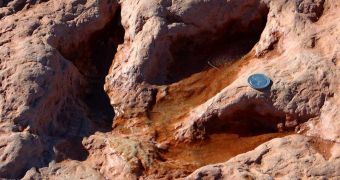Similar dinosaur tracks have been found throughout the world during the years, but this is the first time when these are found in the Arabian Peninsula. The site of the discovery presents the fossilized footprints of 11 sauropods walking together roughly at the same speed along a Mesozoic coastal mudflat. Sauropods were a species of long-necked herbivorous dinosaurs living on Earth between the Jurassic and the Cretaceous periods.
"No dinosaur trackways had been found in this area previously. It's really a blank spot on the map. It's rare to see such a big example of a dinosaur herd. This is interesting social behavior for reptiles.", said Anne Schulp of the Maastricht Museum of Natural History.
The tracks were originally discovered back in 2003 by a Yemeni journalist in a location about 50 kilometers north from the capital of Sana'a. A later investigation conducted by Schulp and Mohammed Al-Wasabi from Sana'a University revealed that they belonged to a species called ornithopod, a large herbivorous dinosaur often referred to as the "cow of the Mesozoic".
The Arabian Peninsula is generally poor in dinosaur fossils, although some of those coming from the Sultanate of Oman were identified by Schulp as possible remnants of a long-necked dinosaur originating from Yemen.
In 2006, the research team concluded that the shape, size and travel speed of the dinosaurs that created them are characteristic to a bipedal species known as ornithopod and a quadruped dinosaur, possibly a sauropod. They are most likely preserved from an age about 150 million years ago, but remained undiscovered because they are hard to spot by untrained eyes and were partially covered by debris.
"It isn't a surprise that they were overlooked", said Nancy Stevens from Ohio University, who also participated in the study. The researchers point out that although ornithopods and sauropods lived roughly in the same time period, such big ornithopods should have not existed late in the Jurassic.
"We really want to learn when did which dinosaurs live where, and why was that? How did the distribution change over time, why did one replace another and move from one place to another?", said Schulp.
"This international collaboration provides an exciting new window into evolutionary history from a critically undersampled region. These trackways help us to assemble a more detailed picture of what was happening on the southern landmasses. It's exciting to see new paleontological data coming out of Yemen - and I think there is a lot more to discover", Stevens added.

 14 DAY TRIAL //
14 DAY TRIAL //